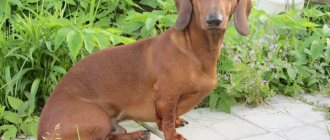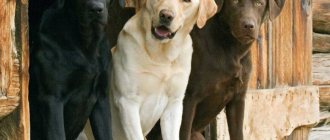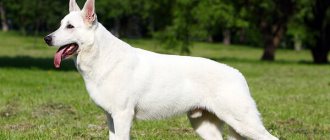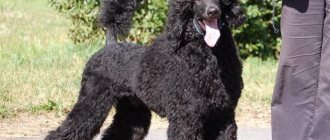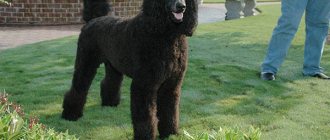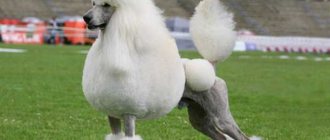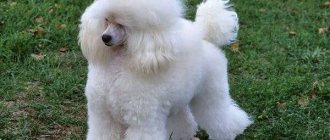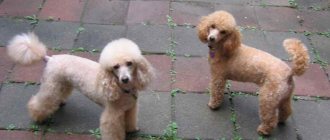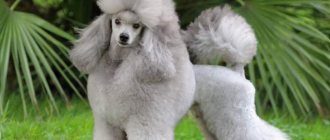Poodle lovers probably know about the variety of colors, but many of them are not recognized by standards, although regardless of coat color, a poodle remains a poodle and its owner’s favorite.
The FCI standard specifies only six colors of poodles, but when dogs with different coat colors are crossed, unusual puppies are born. At the same time, it is very difficult to specifically breed dogs with unusual hair; this phenomenon is often unpredictable, although if you understand the genetics of colors, then sometimes you can achieve the desired result. One of the main requirements is that the wool must be evenly colored.
Coat colors according to the standard
The World Canine Federation has officially recognized the following colors: black, white, brown (chocolate), silver (gray), red, apricot, harlequin, black and tan. Let's look at each of them in more detail.
Black
This color is considered a true classic. These are the dogs that can most often be found both at exhibitions and on the streets of the city. There is even an opinion among breeders that the quality of the outer hair of charcoal-colored dogs is much better than that of their counterparts of other colors. Dogs whose “fur coat” has a deep and rich shade are considered a real standard of beauty. Shades and inclusions of guard hairs of a different color significantly spoil the appearance of the animal and lower its ratings at exhibitions.
Important! A black poodle's eyes are always brown, the nose, lips, skin around the eyes and claws are dark. The skin tone of dogs of this color is blue-gray.
White
This color, like black, is not unusual. White poodles look impressive and rich, but only with proper care. White wool that is not washed and brushed becomes unattractive over time.
White Poodle puppies may be born with an apricot-colored coat that will begin to lighten over time. The skin of these dogs is either soft pink or spotted. The eye color of white dogs is brown, the nose, lips, paw pads, eye rims and claws are dark. Sometimes puppies are born with pink noses, but over time the skin turns black.
Important! From time to time, snow-white babies are born to parents of different colors. This is not welcomed by breeders, and such puppies are not allowed for breeding. This is explained by the fact that from such parents full-fledged multi-colored “children” will not be born.
Brown (chocolate)
Purebred individuals with this shade of coat should not be too dark or, on the contrary, almost black. The brown color in this version resembles dark chocolate. The only area where lighter hairs are allowed is the tips of the ears. Chocolate Poodles have brown or dark amber eyes. The skin should match the coat. The nails, rim around the eyes and nose of these dogs are more black than brown.
Important! The skin on the nose of brown poodles can be liver-colored, but dogs with dark noses are more valued at shows.
Silver
The gray coat color of a poodle is considered the most complex, as it takes 2-3 years to develop. Puppies born with black fur gradually turn into dogs with silver fur. The first signs that “Artemonchik” will turn gray should be visible already at six weeks of age. The paws and muzzle begin to lighten first. The skin color of such poodles is gray, the eyes are brown, the nose and lips are black.
Important! How to determine if a puppy is related to the silver color? We need to shave him bald. The fur at the roots should be light.
Red
This color can be compared to mahogany. Sometimes the coat of red poodles can become lighter in color. In purebred individuals, the skin color matches the coat. The eyes are brown, the color of the claws is brown or black.
Important! The red poodle's nose color is mostly black, but sometimes puppies can be born with lighter noses.
Apricot
Apricot poodles have coats that can be of different shades, the main thing is that they are not close to white or dark brown. Babies are born almost brown, but over time their fur becomes significantly lighter. The development of color can take up to two years. Older apricot-colored dogs often become almost beige, losing the intensity of the shade of their coat.
Apricot poodles have brown eyes. The claws are dark brown, the nose and skin around the eyes are black.
Harlequin
This option was introduced into the standard relatively recently (in the early 2000s). "Harlequins" are always two-color - a combination of black and white. The main tone is white, there should be more than half of it. In black there are marks scattered on the back. The dog's head, paws and chest may also be dark.
Important! Most often, “harlequins” are born as a result of crossing black and gray, white and black poodles.
Black and tan
Adopted in the same way as “harlequin” recently. In fact, it is a collective concept that includes poodles, which are 80% black. Tan marks can be either red or red, red, gray, or apricot.
Brief description of the breed
Varieties of poodle breeds
Poodle breeds differ in external characteristics: color, size, etc. But regardless of this, dogs must have a proportional, graceful physique and be slender:
- Torso. The constitution is dry, the length is not much greater than the height at the withers. Short, harmonious and tight back, powerful neck, with a slightly convex scruff. The croup is rounded, but not sloping. The width of the chest is 2/3 of its depth.
- Paws. Proportionate, hardy and straight. The distance from the ground to the elbows is equal to 5/9 of the height of the dog at the withers. Small, arched, thick toes with hard pads.
- Muzzle. Pointed, slightly elongated, length equal to 9/10 of the length of the cranial lobe. Almond-shaped eyes should not be bulging. Long, large, drooping ears set low. A black nose is found in snow-white, silver and black individuals, and a brown nose is found in coffee-colored ones. The teeth are strong with a scissor bite.
Interesting to know! Cynologists still argue about the origin of the breed precisely because of the size variations of the breeds.
Presumably, the creation of the breed was influenced by retrievers, Maltese, pointers, and greyhounds. The original images of dog breeds similar to the poodle appeared in the 5th-4th century BC. e. on bas-reliefs of Roman tombs, on Greek and Roman coins.
Representatives of the breed are long-lived: their age can reach 25 years.
Non-standard options
Colors that are not included in the appearance standard and are considered defective include:
- brindle;
- sable;
- silver beige;
- coffee;
- blue;
- marble.
A poodle, no matter what coat color it has, always looks impressive and unusual. For a person who has not previously had experience communicating with representatives of this breed, it is important to remember that the intensity of the shade of his pet can be affected by many factors, including nutrition, molting, and hormonal changes.
Similar articles
Content
- What is color and suit in dogs
- Poodle breed colors
- How to choose a healthy puppy
When a person chooses a pet, he gives preference not only to a certain breed, but also focuses his attention on the color; it comes in different shades and colors, striking with its beautiful patterns and appearance. Genetics is one of the main points in a dog’s appearance; the color, type of coat and proportions depend on it. Check out the colors of the Poodle breed.
Buying a puppy
Before purchasing a Miniature Poodle, you need to weigh the pros and cons of such a decision. From the moment the puppy crosses the threshold of the house, the life of its inhabitants will change. You will have to include caring for your dog into your usual daily routine. It will take time to walk and raise the dog, to prepare a diet and go to the veterinarian.
To purchase a puppy, it is advisable to contact a specialized nursery, where they will issue documents for the dog, show its parents, and familiarize them with the rules of keeping. How much does a Miniature Poodle puppy cost? The price depends on the class of the dog and the reputation of the breeder. As for the average cost, it starts from $100 and can reach several thousand for elite show puppies.
Feeding
The Miniature Poodle's diet should be balanced. In no case should you include fatty foods in your diet: a dog’s weak liver reacts instantly. The main part of the Miniature Poodle's diet consists of meat products. The dog should be fed frozen beef or lamb.
Offal is good for your dog, but it should be boiled before eating. Once or twice a week, the dog should be fed boiled sea fish. The menu includes fermented milk products: cottage cheese or kefir. Don't forget to give your pet semi-liquid cereals and wholemeal bread. To saturate the animal's body with vitamins and minerals, the dog must be fed vegetables.
Training and education
Training poodle puppies begins with toilet training and a place to sleep. The first one is much easier. When the baby has explored the house well, he needs to arrange and show him a special place, for example, a plastic tray with newspapers.
The most popular dog names in alphabetical order with recommendationsShar Pei - history of the breed, character traits, care and possible problems + 87 photos
American Bulldog - history of the breed, appearance, specifics and characteristics, care (100 photos + video)
Poking your pet's nose into a puddle is a hopeless matter; you need to train it with patience. The situation is even stricter with the bed. Show restraint, otherwise the dog will easily occupy your own sleeping place.
The next task will be leash and collar training. Once your poodle gets used to wearing it, you can start practicing commands such as “near”, “place”, “sit”, “lie down”. Encourage the animal with words and treats - learning will go faster.
A poodle needs to be walked a lot. And always in company, because he loves communication. And a walk wouldn’t hurt the owner or hostess either.Poodle character
The poodle (of any size) is unusually friendly and good-natured. He quickly becomes attached to his owners, loves all kinds of games and pranks (children especially love him for this). Has a tendency to protect and protect, even being initially smaller than the enemy.
The Poodle is a very attentive dog. He is an excellent listener, always ready to support his interlocutor.He is easy to train, quickly remembers commands, but is prone to cunning and can use them to his advantage.
Children who grow up with a poodle gain a wonderful experience of responsibility and develop a lifelong love for all living things. For older people, caring for a cheerful and non-aggressive dog will help them keep themselves in good shape.
Health
The lifespan of a Miniature Poodle depends on the conditions in which it lives, proper feeding and the presence of chronic diseases. On average it is 16 years. There are a number of diseases characteristic of dogs of this breed:
- Ear diseases of an infectious nature.
- Deafness in one or both ears (due to ear diseases or congenital).
- Diabetes (caused by obesity, old age or genetic predisposition).
- Retinal atrophy (gradually leading to cataracts).
- Tendency to cardiovascular diseases.
- Hypothyroidism (cause: dysfunction of the thyroid gland). The first signs of the disease: excess weight, hunger, skin problems.
